Rijeka
Rijeka (literally "River") is a city in Kvarner Bay, a northern inlet of the Adriatic Sea in Croatia. It is the principal seaport of the country. It had about 129,000 inhabitants in 2011, with the greater city area reaching up to 200,000, and is Croatia's third largest city.
Understand
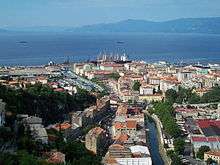
The city of Rijeka is a unique cosmopolitan city with a very turbulent history, especially during the 20th century. For instance, Rijeka was ruled by eight different countries between 1918 and 1991, so theoretically, a citizen of Rijeka born in 1917 could have had eight different passports without ever leaving the city limits. Such rapid changes of events led to a strong local identity for the city.
Rijeka is a major Croatian port, in the very heart of Kvarner Gulf. Because of its location, Rijeka is a crossroads of land and sea routes, connected with the rest of the world by air, bus, train and ship lines. Despite often being described as a predominantly industrial and port city, Rijeka is an interesting city with beautiful architecture of mostly secession style, a good choice of museums and quality night-life.
In the beginning of the 20th century, Rijeka was one of the main European ports and had weekly passenger service to and from New York. The famous ship Carpathia, which saved most of the survivors from the Titanic, was heading from New York to Rijeka, and most of the crew on the ship was Croatian. Thanks to that, one of life-belts from the Titanic is preserved in the Rijeka Naval Museum.
Rijeka was also the first fascist state in the world, before Mussolini's Italy or Hitler's German Reich. A mixture of fascism, anarchism and elements or dadaism was the basis for the constitution of Reggenza Italiana del Carnaro (Italian Regency of Kvarner), a short-lived state created in 1919, after a coup d'etat of Italian war veterans led by Gabriele D'Annunzio, often called the pioneer of fascism. To make it more awkward, this unusual state was the first international state that recognized Lenin's USSR.
On the bright side, from 1920 to 1924, Rijeka was an independent neutral state. A status very similar to the later status of Gdansk provided Rijeka with independence and neutrality. The official language in the Free State of Rijeka were Croatian, Italian and Hungarian, in order to provide maximum care for all minorities in the city.
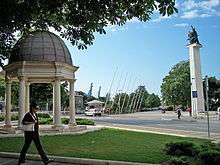
Woodrow Wilson, President of United States, recommended Rijeka in 1919 as a head of the League of Nations. After Second World War, Rijeka was one of candidates for hosting the headquarters of the United Nations. The idea was to reintroduce Independent State of Rijeka as a special United Nations neutral state.
Modern Rijeka is actually made from two original cities that were separated by river Rječina. On the west was Fiume or Rijeka and on the east Sušak, the rival counterpart of Rijeka mostly inhabited by Croatians and most of the 19th and early 20th century under Yugoslavian or Croatian administrative rule. Those two cities were merged in 1945. To symbolically connect the city, a wide pedestrian bridge was built in front of Hotel Kontinental which was turned into a square. Most of the people are not aware that there is actually a river under this wide square. It is popular place for meeting and socializing, especially for the younger generations.
With coming to Rijeka, you are joining to the list of people together with Che Guevara, James Joyce, Franz Liszt, Dora Maar, Enrico Caruso, Benito Mussolini, Gabriele D'Annunzio, Josip Jelačić, Bobby Fischer, Saddam Husein, Gamal Abdel Nasser, Johnny Weissmueller, Pope John Paul II and many others that have been in Rijeka before.
Rijeka will be a "European Capital of Culture" for 2020, an honour it shares with Galway.
Get in
By car
Travellers heading from Zagreb (185 km (115 mi)) should take the A1 to Bosiljevo and then take the A6 to Rijeka. The A6 is a 4-6 lane motorway over hilly terrain with many tunnels, bridges and viaducts.
Travellers from Trieste (76 km (47 mi)) should take A7 upon entering Croatia at Pasjak or Rupa border crossing.
Travellers from Split (380 km (240 mi)) can take A1 to Žuta Lokva and then proceed via Senj and Crikvenica to Rijeka, or A1 north to Bosiljevo and then A6 to Rijeka.
By plane
- 🌍 Rijeka airport (RJK IATA) (on the nearby island of Krk, around 35 km (22 mi) from the Rijeka city center.). The airport opened in 1970 and mostly seas seasonal traffic.
- Air Baltic connects Rijeka with Riga, Copenhagen, Moscow and Helsinki.
- Arkia connects Rijeka to Tel Aviv.
- Croatia Airlines connects Rijeka to London and Munich.
- Czech Airlines connects Rijeka with Kosice.
- Eurowings connects Rijeka with Hamburg, Bonn/Cologne, Berlin, Stuttgart and Dusseldorf.
- Nordica connects Rijeka to Tallinn.
- Norwegian connects Rijeka with Oslo.
- Ryanair connects Rijeka to Stockholm, London and Charleroi.
- Trade Air connects Rijeka to Split, Dubrovnik, Osijek and Zagreb.
Bus shuttle from Rijeka Airport to city is operated by Autotrans. Price for a ride from Rijeka to Airport is 50 kn. See schedule here.
There are regular bus services from Rijeka into Zagreb Airport for connections there. The Croatia Airlines website has more information.
From Airport Rijeka to city it is possible to come with official Rijeka Airport Taxi Transfer Service. All information you can take on the official website.
By train
Rijeka has been an important railhead since its early days as one of the major ports of the Austro-Hungarian Empire, and is connected with direct services to capital of Croatia, (Zagreb, from where you can take direct trains to other major cities in Croatia. There are also twice daily services to Ljubljana in Slovenia, with evening train continuing to Munich and one train via Zagreb each day to Budapest. During the summer there is also connection to Budapest trough Ljubljana. Services to Pula by train are possible, though as the two cities are not connected in Croatia by rail (the connection is now in Slovenia), a designated bus is timed to take you that part of the journey. There are no direct connection to southern Croatia, but it is possible to get to Split From Rijeka with changing the train in Ogulin. Journey is long (around 11 hours) but since there is possibility for overnight train, it is not bad option as well. It is possible to travel to Pula by train, with a bus connection from train station to Lupoglav, from where you take a train to Pula. Bus service is provided by Croatian Railways and you need to buy just one ticket.
The 🌍 railway station is in Krešimirova Street, at the northern edge of the town area. It is 5 minutes' walk from bus station. Information on rail services is available on the information counter, or on the telephone +385 60 333-44-44. You can buy tickets or make reservations at the station ticket-office (+385 51 21-33-33). The railway station has a luggage lockers open from 9AM to 9PM, and cost 15 kn. There is also a tourism information office in the station building, but is open odd hours - although there is a large map at the front of the station building. There is also an ATM at the station.
The Croatian Railways website contains good information on train times and prices, and there is also some information for travel Rijeka-Ljubljana on the Slovenian Railways site.
By bus
Rijeka is connected by bus with bigger cities in Croatia, Slovenia, Italy and elsewhere in Europe. The busy 🌍 bus terminal is in the city center at the foot of the imposing Capuchin church, on Trg Žabica. You can find good information on timetable and fares at the Autotrans website or in their office (which also sells tickets), at Žabica 1 or by telephone +385 (0)60 30-20-10. Tickets purchased through company's website are 5% cheaper. There is a left-luggage office next to the newspaper and cigarette stand, open from 5:30AM till 10:30PM (the latest of all the transport modes in Rijeka). Luggage safekeeping costs 9 kn. Eurobusways operates a direct Budapest-Rijeka Bus line.
By ship
As one of the largest ports of the Austro-Hungarian empire, and the largest port in Croatia, ships play an important role in the life of Rijeka.
Of best use to travellers from Rijeka is the Jadrolinija ferry service. The state-owned company operates small fast vessels to the nearby islands. Car-carrying ferries down the Adriatic Coast to Split and Dubrovnik have been cancelled. The passenger terminal is in the city center, and on the waterfront just near the Jadrolinija office building (where one buys tickets on the ground floor) is a left-luggage office.
Get around
By foot
Most of Rijeka is accessible on foot, and traffic is banned on Korzo in the heart of the city.
By public transport
For those that are further away from the city or tired, an efficient local bus network operates operating in a single-direction, circular movement around the central city area, and fanning out in all directions. Buses #2 and #8, to Trsat, are probably the most useful for tourists, and a good alternative to the 561 stair climb to the top of the hill.
By taxi
Rijeka has a cheap and well organized taxi service that will get you anywhere in the city for approximately €10 or less. In the centre of the town there are three taxi terminals, at the Bus station, +385 51 335 138; in the Matije Gupca Street, +385 51 335 417, at the railway station, +385 51 332 893 and there is also a taxi van available.
- Taxi Rijeka +385 91 516 5236
- Taxi Cammeo +385 51 313 313
- Taxi Adria +385 51 301 301
- VIP car service +385 91 11 555 60
- JAM Transfer. Taxis usually come within 10 to 15 minutes from the call except in busy summer season where it depends on how much business they have. Online booking available.
Talk
Besides Croatian, Italian is de facto semi-official and featured on many signs in the city. Most natives of Rijeka understand it well and some speak it fluently. Older native citizens speak their own dialect of Italian language - Fiumani, named after the Italian name for the city - Fiume. English is widely understood and spoken by younger people and hotel/restaurant staff. Some people also know some German.
See
The best way to see Rijeka’s cultural and historical monuments is to follow the tourist path that gathers all of the most important sights for this town and its history. Most of them are accessible by foot, as they are mostly located in or near the city centre, but to see Trsat Castle you will need to take a short car/bus ride. Other option, the more adventurous one, is to climb 561 Trsat stairs that lead from city centre to Trsat. The Trsat Castle is worth the effort. Also, a helpful travel companion is free AdriaGuide Rijeka mobile application, for smart phones and GPS navigation.
- 🌍 Trsat Castle. represents a strategically embossed gazebo on a hill 138 meters above sea level that dominates Rijeka. As a parochial centre it was mentioned for the first time in 1288. Trsat Castle is one of the oldest fortifications on the Croatian Coast, where the characteristics of the early medieval town construction have been preserved. Today Trsat Castle, beside the souvenir shop and the coffee shop, is enriched with new facilities – gallery space where art exhibitions are held as well as open-air summer concerts and theatre performances, fashion shows and literary evenings.
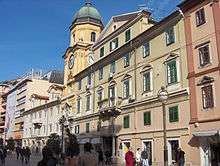
- 🌍 City Tower (Gradski Toranj). A symbol of Rijeka and a good example of a typical round tower access-point, which leads into the fortified town. Today it dominates the central part of Korzo and is often used as a meeting place for local people.
- 🌍 Our Lady of Trsat's Sanctuary. This is the largest centre of pilgrimage in western Croatia. It is famous for its numerous concessions and for the pilgrimages by numerous believers throughout the year, and especially on the Assumption of Mary holiday.
- No supermarket can replace the charm of the personal contact with the vendor or the excitement of the unpredictable purchase at the main City market – Placa. The harmonious compound of two pavilions and a Fish market building where, in the morning hours, the real Rijeka can be experienced.
- Torpedo – launching ramp The launching ramp from 1930s is an item belonging to the closed torpedo production factory. It is proof of the technical inventive of Rijeka during this period and at the same time is an important world landmark of industrial heritage.
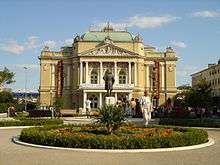
Museums, collections and exhibitions – Rijeka is a city with an unusual, turbulent past. The best places to discover the whole story on Rijeka are its museums, among its rich collections and exhibitions.
- Maritime and Historical Museum of the Croatian Littoral Located in the beautiful Governor’s Palace building, it preserves a large part of Rijeka's history and maritime tradition. Besides its continuous ethnographic exhibition, visit our collection of furniture and portraits of people from Rijeka’s public life.
- Natural History Museum. Besides the botanical garden, the museum is a multimedia centre with an aquarium containing species from the Adriatic Sea. Besides fish, sharks and sea rays, the museum also conserves species of insects, reptiles, birds and amphibians. Ideal entertainment for both children and adults.
- Rijeka City Museum The museum includes eleven collections: fine arts, arts & crafts, numismatics, valuable objects, medals, arms from the Second World War and from the Croatian War of Independence, a collection of theatre and film material, philately, photography, press and technical collections.
- Modern and Contemporary Art Museum, Krešimirova 26. Tue – Fri: 11AM – 8PM Sat – Sun: 11AM – 6PM. The museum collects works of art by Rijeka artists from 19th century and Croatian and foreign artists from 20th and 21st centuries.
- Peek & Poke - "Museum" of old computers. In this continuous exhibition over 1000 expositions are exhibited from around the world and from Croatian computer history. Located in an area of 300 m², in the centre of Rijeka it is the largest exhibition of its kind in this part of Europe.
- The St. Vitus Cathedral Sacral Collection The collection is located in an attractive location, in a gallery above the internal part and above the church's altar, whilst the thesaurus is located in the atrium of the cathedral’s locale. The sacral “Jesuits' heritage” collection includes some very rare exponents.
- Thesaurus and Gallery of Our Lady of Trsat’s Sanctuary. The monastery treasury holds works of extraordinary esthetic and material value, paintings, reliquaries, lamps, chalices, ecclesiastical robes, while the Chapel of Votive Gifts houses gifts since the 19th century.
- Memorial Library and the Mažuranić-Brlić-Ružić Collection. The library and Mažuranić-Brlić-Ružić collection are at Pećine, in Rijeka inside the villa of the famous Rijeka's family, Ružić.
- Permanent Glagolitic Alphabet Exhibition. A permanent exhibition has been collocated in the Rijeka University Library known as “Glagoljica” in which the Glagolitic written and printed heritage has been presented, especially that of the north Adriatic area where the first Croatian (Glagolitic) books were printed.
- Petar Kružić staircase.
Do
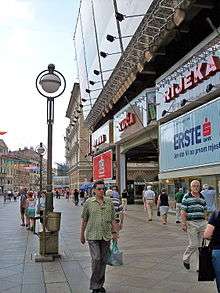
- Theatres: You can choose from those suitable for adults or for children, go either at the Croatian National theatre or at one of Rijeka’s smaller independent theatres. When it comes to cinema, in Rijeka you can find art cinema and multiplex.
- For those who like to be active while they travel and maybe want to shed a bit of sweat here are a few recommendations:
- Kantrida pools. Complex of five newly furnished pools, located by the sea with an amazing view over the nearby islands and Istria.
- If you miss the adrenaline, some ten kilometers from Rijeka is an auto-moto track Grobnik where you can try your riding skills or watch how the professionals do it.
- Diving around the coast of Rijeka. The Adriatic has one of the most indented coasts in Europe and its northern part is especially attractive for divers who like to dive on the underwater cliffs. The area offers various diving conditions both for beginners and for advanced divers. Besides the extremely clear sea and wealth of underwater life, underwater cliffs with gorgonian corals and caves can be found here as well as ship wrecks.
- For nature lovers, the ones that like to walk, watch the stars or just lie on the beach, there are many places to indulge in such activities:
- Astronomical Centre Rijeka. Learn about the stars in this unique astronomy centre both in Croatia and abroad. Besides sky objects, from Sveti Križ hill, where it is located, a beautiful view extends over the Rijeka Bay and mountain hinterland.
- Rijeka’s beaches. Rijeka has the beach for everyone’s taste and thanks to the Mediterranean climate, the bathing season begins in spring and lasts until late autumn. With regard to the city location, Rijeka’s beaches are located to the far east and to the far western parts of the city, and you can choose your favorite – large and noisy or small and secluded, pebbly, concrete, rocky, hidden. City buses drive to all beaches and there is free car parking close to all of them.
- 🌍 Plaža Sablićevo. One of the nicest beaches close to Rijeka.
- Parks and promenades. Nature lovers and more active visitors can discover the city in a different way – by researching Rijeka’s promenades by the sea, urban or forest areas, and for those less active, parks are the best option for taking a break during a walk around Rijeka.
Buy
- Rijeka’s main market – Placa No supermarket can replace the charm of the personal contact with the vendor or the excitement of the unpredictable purchase at the main Rijeka market – Placa. The harmonious compound of two pavilions and a Fish market building where, in the morning hours, the real Rijeka can be experienced.
- Shopping in the city centre – most shops are open from 8AM until 8PM, Saturdays and Sundays usually until 1PM. There are several 24/7 stores, and if you need cigarettes or newspapers after 8PM they can be bought at the kiosk that works all night, at the main bus station, Žabica. You can purchase all that you need in one of the larger commercial centers in Rijeka, the biggest one is Tower Center Rijeka, while Zapadni Trgovački Centar is the newest.
- Souvenir shops – authentic souvenirs can be bought at the Tourist Information Centre, two Rijeka’s galleries that have received the “Authentic from Rijeka” and “Special quality” labels – Mala galerija Bruketa and Galerija Art, Zeleno i plavo (Green and Blue) – autochthonous products shop, La Mamma Delicije on Trsat, and Bazilisk Souvenir Shop located in the very centre of Trsat Castle. Rijeka also has an online souvenir web shop.
Eat
- Restaurants. There are numerous restaurants offering domestic and international food. Try some of their local fish specialties and also meat and vegetarian dishes as well as exotic specialties. If you didn’t walk into one of the more exclusive restraints in Rijeka, such as Zlatna školjka, Kamov or Municipium, you will find the prices to be mostly moderate.
- Taverns. Experience the relaxed atmosphere of Rijeka’s taverns which in a typical local environment will offer you their specialties at moderate prices.
- Pizzerias and fast food - there are also many fast-food restaurants, some of them open 24 hours, such as Žabica on the main bus station Žabica and Food City on the Korzo promenade.
Drink
Wherever you go in Rijeka, you will find a place to drink and relax. There are hundreds of bars and cafes across the city. There are three ships docked in the harbor (city center) with bars, casino, and a night club – Arca Fiumana, Marina club and Club Nina2.
- Club Palach One of the oldest clubs in Rijeka, with 3 bars, 4 floors, one small free cinema room, gallery for young artists and comic book store, it's also one of the most interesting cafés/clubs in Rijeka.
- Stereo dvorana The centre of Rijeka’s urban culture. The program includes and bonds urban life and multiculturalism with maybe the best conditions in Croatia for concerts and events.
- Café bar Karolina – a coffee bar located by the sea with a large terrace and a view of the boats in the Port of Rijeka. In the evening hours coffee drinking is replaced by music and dancing.
- Cukarikafe bar – works with the same intensity during the day and during the evening. It is special for its creative furnishings, relaxing music and atmosphere which also moves on two terraces during the warmer weather.
- Pepe Rosso Bar is a tavern, but not a totally conventional one with tango and salsa nights, a variety of promotions – from wine to books, exhibitions and performances, entertainment with DJs or live music.
- Café bar Nad urom is located on the last floor of the Korzo shopping centre, with a view over Rijeka’s rooftops and the Korzo, during the day offers refreshments and relaxation after shopping and during the weekend there is live music.
- complete list of coffee shops and clubs. The in Rijeka can be found on Rijeka Tourist Board web page.
Sleep
Budget
- Rijeka Youth Hostel. Around a hundred meters from the sea, in one of the most beautiful locations of the city, at Pećine, just 5 minutes by bus from the city centre (it will take you 15 minutes on foot).
- Lounge Hostel Carnevale. A modernly furnished hostel located in Jadranski Square, in the centre of the city of Rijeka, the very heart of the pedestrian zone on the Korzo, the city’s main promenade.
- Hostel Aston At Rijeka’s bus station, one minute’s walk away from the main Korzo promenade. All rooms have a view over the Capuchin Church and close by are all important facilities and a large number of night clubs.
- Kantrida hostelery is 5 km from the centre of Rijeka, on the main road leading to Opatija. It belongs to the semi-opened category type. It is mainly used by the employees and subcontractors of the 3. Maj shipyard and vacant rooms are also offered to passers-by.
- Campsite Preluk. In a small pine and laurel forest next to the sea and a pebbly beach. It is in Preluk, serviced by bus no. 32 which goes to Opatija and is 2 km. from the centre of Opatija. The capacity of the camp is for 500 people.
Mid-range
- . The 125-year-old and completely refurbished 4-star hotel located in the heart of Rijeka. First class accommodation consists of 114 air-conditioned rooms, six suites and a presidential suite and has its own car park and garage.
- Hotel Jadran. A four-star establishment by the sea. It was reopened in December 2005 after thorough reconstruction. It has 66 single and double bedrooms. Every room is air-conditioned, and has a satellite TV and radio, direct telephone line, Internet connection, safe and mini-bar.
- Hotel Continental. A three-star hotel built in 1888 with 37 double bedrooms, 1 single bedroom and 4 hotel suits on two floors. All rooms are equipped with a TV and a direct telephone line, while the access to the Internet is possible via modem, using the telephone connection port in the room. A complete warm breakfast in included in the price of approximately 400 kn per night for a single.
- Hotel Neboder. Renovated in 2007, this 14-story hotel is part of the complex of the Croatian Cultural Centre. The best part about the hotel is the amazing view of the eastern part of the Istrian peninsula and Učka, Opatija, Rijeka, the small towns of Kostrena and Kraljevica and the island of Krk.
Go next
- Opatija, once the secluded seaside resort of the rich and famous, is just a short 20-minute bus ride along the coast from Rijeka. Bus #32 departs frequently. It is a great place to go swimming. There are many fine restaurants and hotels (both of which seem to be lacking in Rijeka). Try to get a table at Le Mandrac in Volosko harbour, it is one of the finest restaurants in Croatia.
- Until 2014, there was possibility to travel by Jadrolinija Ferry to Dubrovnik, Split, Stari Grad, Korčula, and Bari in Italy. Since there are rumors to reintroduce this line, keep in mind this wonderful option for trans-Croatian coastline journey. Journey time was up to twenty hours, so getting a cabin is highly recommended. On the boat, the restaurant serves up some decent food at surprisingly reasonable prices, but bear in mind that the 23% tax is not included on the menu. There is nothing in the way of entertainment, so bring some entertaining company or a good book.
- Islands of Rab, Pag, Losinj, Cres, Susak, Unije and Ilovik also can be reached by daily catamarans, which leave Rijeka at afternoon. One-way prices for adults are up to 60 kn, depending on destination.
- Buses are available to:
- Trains are available to: